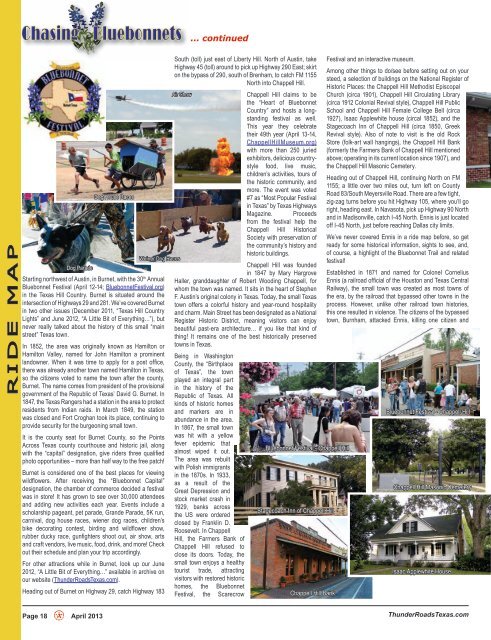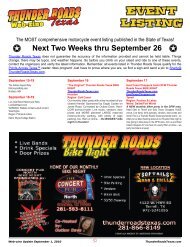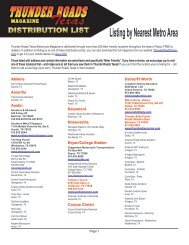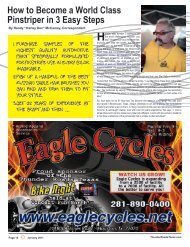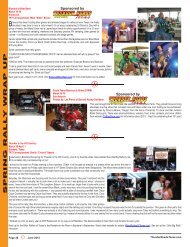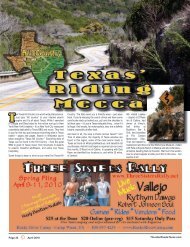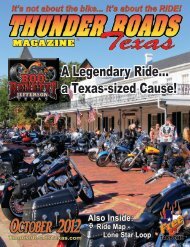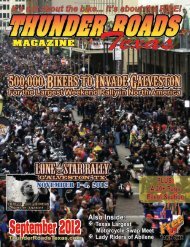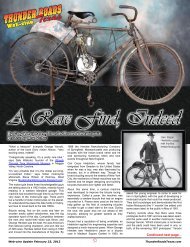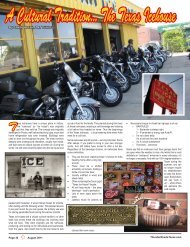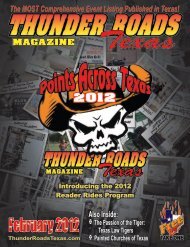April 2013 - Thunder Roads Texas Motorcycle Magazine
April 2013 - Thunder Roads Texas Motorcycle Magazine
April 2013 - Thunder Roads Texas Motorcycle Magazine
Create successful ePaper yourself
Turn your PDF publications into a flip-book with our unique Google optimized e-Paper software.
RIDE MAP<br />
Dog Parade<br />
Starting northwest of Austin, in Burnet, with the 30 th Annual<br />
Bluebonnet Festival (<strong>April</strong> 12-14; BluebonnetFestival.org)<br />
in the <strong>Texas</strong> Hill Country. Burnet is situated around the<br />
intersection of Highways 29 and 281. We’ve covered Burnet<br />
in two other issues (December 2011, “<strong>Texas</strong> Hill Country<br />
Lights” and June 2012, “A Little Bit of Everything…”), but<br />
never really talked about the history of this small “main<br />
street” <strong>Texas</strong> town.<br />
In 1852, the area was originally known as Hamilton or<br />
Hamilton Valley, named for John Hamilton a prominent<br />
landowner. When it was time to apply for a post office,<br />
there was already another town named Hamilton in <strong>Texas</strong>,<br />
so the citizens voted to name the town after the county,<br />
Burnet. The name comes from president of the provisional<br />
government of the Republic of <strong>Texas</strong>’ David G. Burnet. In<br />
1847, the <strong>Texas</strong> Rangers had a station in the area to protect<br />
residents from Indian raids. In March 1849, the station<br />
was closed and Fort Croghan took its place, continuing to<br />
provide security for the burgeoning small town.<br />
It is the county seat for Burnet County, so the Points<br />
Across <strong>Texas</strong> county courthouse and historic jail, along<br />
with the “capital” designation, give riders three qualified<br />
photo opportunities – more than half way to the free patch!<br />
Burnet is considered one of the best places for viewing<br />
wildflowers. After receiving the “Bluebonnet Capital”<br />
designation, the chamber of commerce decided a festival<br />
was in store! It has grown to see over 30,000 attendees<br />
and adding new activities each year. Events include a<br />
scholarship pageant, pet parade, Grande Parade, 5K run,<br />
carnival, dog house races, wiener dog races, children’s<br />
bike decorating contest, birding and wildflower show,<br />
rubber ducky race, gunfighters shoot out, air show, arts<br />
and craft vendors, live music, food, drink, and more! Check<br />
out their schedule and plan your trip accordingly.<br />
For other attractions while in Burnet, look up our June<br />
2012, “A Little Bit of Everything…” available in archive on<br />
our website (<strong>Thunder</strong><strong>Roads</strong><strong>Texas</strong>.com).<br />
Heading out of Burnet on Highway 29, catch Highway 183<br />
Page 18 H <strong>April</strong> <strong>2013</strong><br />
Dog House Races<br />
Weiner Dog Races<br />
... continued<br />
South (toll) just east of Liberty Hill. North of Austin, take<br />
Highway 45 (toll) around to pick up Highway 290 East; skirt<br />
on the bypass of 290, south of Brenham, to catch FM 1155<br />
North into Chappell Hill.<br />
Air Show<br />
Chappell Hill claims to be<br />
the “Heart of Bluebonnet<br />
Country” and hosts a longstanding<br />
festival as well.<br />
This year they celebrate<br />
their 49th year (<strong>April</strong> 13-14,<br />
ChappellHillMuseum.org)<br />
with more than 250 juried<br />
exhibitors, delicious countrystyle<br />
food, live music,<br />
children’s activities, tours of<br />
the historic community, and<br />
more. The event was voted<br />
#7 as “Most Popular Festival<br />
in <strong>Texas</strong>” by <strong>Texas</strong> Highways<br />
<strong>Magazine</strong>. Proceeds<br />
from the festival help the<br />
Chappell Hill Historical<br />
Society with preservation of<br />
the community’s history and<br />
historic buildings.<br />
Chappell Hill was founded<br />
in 1847 by Mary Hargrove<br />
Haller, granddaughter of Robert Wooding Chappell, for<br />
whom the town was named. It sits in the heart of Stephen<br />
F. Austin’s original colony in <strong>Texas</strong>. Today, the small <strong>Texas</strong><br />
town offers a colorful history and year-round hospitality<br />
and charm. Main Street has been designated as a National<br />
Register Historic District, meaning visitors can enjoy<br />
beautiful past-era architecture… if you like that kind of<br />
thing! It remains one of the best historically preserved<br />
towns in <strong>Texas</strong>.<br />
Being in Washington<br />
County, the “Birthplace<br />
of <strong>Texas</strong>”, the town<br />
played an integral part<br />
in the history of the<br />
Republic of <strong>Texas</strong>. All<br />
kinds of historic homes<br />
and markers are in<br />
abundance in the area.<br />
In 1867, the small town<br />
was hit with a yellow<br />
fever epidemic that<br />
almost wiped it out.<br />
The area was rebuilt<br />
with Polish immigrants<br />
in the 1870s. In 1933,<br />
as a result of the<br />
Great Depression and<br />
stock market crash in<br />
Bluebonnet Festival - Chappell Hill<br />
1929, banks across<br />
the US were ordered<br />
closed by Franklin D.<br />
Roosevelt. In Chappell<br />
Hill, the Farmers Bank of<br />
Chappell Hill refused to<br />
close its doors. Today, the<br />
small town enjoys a healthy<br />
Stagecoach Inn of Chappell Hill<br />
tourist trade, attracting<br />
visitors with restored historic<br />
homes, the Bluebonnet<br />
Festival, the Scarecrow<br />
Chappell Hill Bank<br />
Festival and an interactive museum.<br />
Among other things to do/see before setting out on your<br />
steed, a selection of buildings on the National Register of<br />
Historic Places: the Chappell Hill Methodist Episcopal<br />
Church (circa 1901), Chappell Hill Circulating Library<br />
(circa 1912 Colonial Revival style), Chappell Hill Public<br />
School and Chappell Hill Female College Bell (circa<br />
1927), Isaac Applewhite house (circal 1852), and the<br />
Stagecoach Inn of Chappell Hill (circa 1850, Greek<br />
Revival style). Also of note to visit is the old Rock<br />
Store (folk-art wall hangings), the Chappell Hill Bank<br />
(formerly the Farmers Bank of Chappell Hill mentioned<br />
above; operating in its current location since 1907), and<br />
the Chappell Hill Masonic Cemetery.<br />
Heading out of Chappell Hill, continuing North on FM<br />
1155; a little over two miles out, turn left on County<br />
Road 83/South Meyersville Road. There are a few tight,<br />
zig-zag turns before you hit Highway 105, where you’ll go<br />
right, heading east. In Navasota, pick up Highway 90 North<br />
and in Madisonville, catch I-45 North. Ennis is just located<br />
off I-45 North, just before reaching Dallas city limits.<br />
We’ve never covered Ennis in a ride map before, so get<br />
ready for some historical information, sights to see, and,<br />
of course, a highlight of the Bluebonnet Trail and related<br />
festival!<br />
Established in 1871 and named for Colonel Cornelius<br />
Ennis (a railroad official of the Houston and <strong>Texas</strong> Central<br />
Railway), the small town was created as most towns of<br />
the era, by the railroad that bypassed other towns in the<br />
process. However, unlike other railroad town histories,<br />
this one resulted in violence. The citizens of the bypassed<br />
town, Burnham, attacked Ennis, killing one citizen and<br />
Bluebonnet Festival - Chappell Hill<br />
Chappell Hill Masonic Cemetery<br />
Isaac Applewhite House<br />
<strong>Thunder</strong><strong>Roads</strong><strong>Texas</strong>.com


